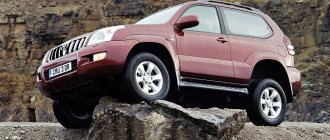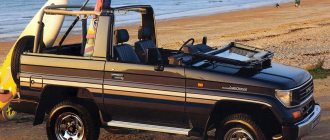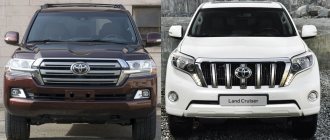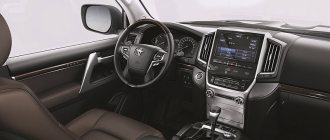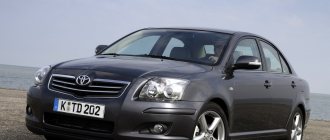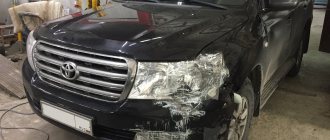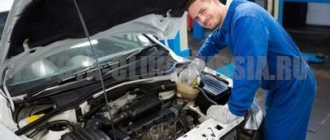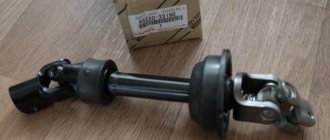June 19 11:56 2017 by Alexey Dmitriev
724
The classic Totota Land Cruised FJ SUVs became a legend during their lifetime. Moreover, in Latin America and Southeast Asia, the original FJ40s still run on the road and serve as everyday workhorses.
Today they are finding a second life in the restoration workshops of the FJ Company from Miami. I asked to visit the guys to learn the secrets of restoring cars that were produced several years before my birth.
Birth of a legend
After World War II, almost all SUVs had military pedigree. Japan was just building its automotive industry, so Toyota took the American Wyllis as a basis and released its first SUV, the Toyota Jeep, in 1953.
After several updates, the Toyota FJ40 appeared, which became the first truly original model. It was this moment that can be considered the birth of the legendary Land Cruiser name. The model quickly gained popularity in the countries of Southeast Asia, Latin America and even in the USA. In Japan, the FJ40 was produced until 1984, but the model turned out to be so popular that its production continued in Brazil under the name Bandeirante until 2001.
Long wheelbase Toyota FJ45 1967 for the American market
In those days, Toyota engines could easily travel up to a million kilometers. Modern cars, God willing, will travel 100 thousand without any problems. The resource of many is limited to a mileage of 250 thousand kilometers.
When you see forty-year-old Toyotas that still move under their own power, you understand that it was then, in the second half of the last century, that Toyota earned a reputation as a manufacturer of indestructible cars.
Model history
The Toyota concern occupied a strong position in the automobile market in the 50s of the last century after the appearance of the 20 series Land Cruiser, but with the release of the 40 series car, the company's reputation was further strengthened. Engineers upgraded the engine, increasing power to 125 hp. With. The Toyota name appears at the top of the car's radiator grille.
Stages of improvement of Toyota Land Cruiser J40:
- In 1963, the exterior and interior of the car were restyled: the Toyota marking moved inside the radiator grille, the steering wheel and dashboard were modified.
- In 1968, motorists were able to appreciate seat adjustment and the benefits of rear-view mirrors. A visor has appeared in the interior of the Land Cruiser 40 series, protecting against glare from the sun's rays. The panel was equipped with a plastic canopy and covered with casing from below.
- In 1973, the B series diesel engine was installed on Toyota. A distinctive feature of the model with a diesel engine was the Diesel nameplate on the radiator grille.
- In 1975, the automaker's designers improved the gasoline engine, increasing power to 135 hp. With. This became possible due to an increase in its volume from 3878 cm3 to 4230 cm3.
- In 1979, the shape of the radiator grille underwent changes. Toyota Land Cruiser 40 series received power steering, disc and parking brakes. Driving in a car has become safer. The driver and passengers felt comfortable in the cabin. For the convenience of motorists, a large fuel tank was installed on the car, holding 85 liters of fuel.
- In the early 80s, a new body was installed on the extended Toyota Land Cruiser chassis (2730 mm). A little later, the wheels acquired radial tires.
The release date of the last Japanese car, the Toyota Land Cruiser 40 series, was October 7, 1984. In Brazil, cars of this model were produced under the Bandeirante label until 2001.
Garage business
The head of the FJ Company, Nelson Calle, spent a lot of time as a child with his grandfather, who in his life only owned two cars, both of which were Toyota FJ40s. The first was released in 1968, and the second in 1982. Every weekend for 10 years, he and his brother and sister rode in the back seat of a Land Cruiser.
When his grandfather passed away, Nelson, along with his brother Juan and cousin Jaime, decided to restore the Toyota to its original condition. In the end, the result impressed Juan so much that he decided to buy the FJ40 and send it to his home in Miami. Thus, the Toyota FJ restoration company was born spontaneously.
Nelson Calle FJ Company
Let's go visit
Keith Ennis
At the company's office in Miami, we were met by Sales and Purchasing Director Keith Ennis. He has a lifelong passion for classic sports cars. So at one of the auto shows he met the Calle brothers, and then they became partners in restoring classic Toyota SUVs.
Today FJ Company is capable of restoring up to 120 cars per year. It takes 8-10 months for one car. The schedule is very strict and the company guarantees that the price will not change, and in case of violation of the deadlines, all money will be returned.
“In the worst case scenario, the client will hear from me that we are taking another week to test the finished car. The company has never missed a deadline in its 5-year history,” says Kate.
The donors for restoration are predominantly cars from central Colombia. The climate there is very dry and cars remain in good condition for many years.
The main restoration workshop is also located in Colombia and there are reasons for this. First of all, the Calle brothers are from Colombia. Secondly, the Toyota FJ40 is very popular in this country and there are many professionals there who can work with this model.
Restoration begins with the search for a suitable specimen. The FJ Company has its own criteria that the “donor” must meet, but among the main ones: Japanese production, minimal corrosion, frame integrity, original motor and gearbox. In addition, the customer can find a car on his own or provide his own.
Such cars roam the roads of Colombia to this day.
The work begins with a complete disassembly of the car, including the removal of glass and window frames. Parts are sorted and stored on a special rack. If the part cannot be restored, then it is replaced with a new one.
The engine is rebuilt and gets a new carburetor (or injector), new starter, pumps (oil, water, fuel), electronic ignition and wiring. Major engine components are measured to ensure they are within tolerance. If not, then the part changes. No detail is left untouched.
The suspension is completely rebuilt, with replacement of bearings, silent blocks and shock absorbers. If the client wants, we install a new Old Man Emu suspension. The brake system is also completely updated.
The transmission is also completely rebuilt, including the front and rear differentials. By default, all bearings, gears, gaskets and rubber bands are replaced with new ones. Since each vehicle is custom built, we fit tires to suit the customer's needs. Finally, every engine and transmission component gets a full cosmetic restoration so it looks like it just rolled off the assembly line.
The frame and all body parts are stripped down to bare metal. The bottom is cleaned of anti-corrosion coatings, all gaps are re-set. The bottom and suspension elements are coated with Rhino Liner.
The engine compartment, including wiring, battery ground straps and batteries are completely replaced. Each part undergoes cosmetic restoration, making them look like new.
The interior is being restored in strict accordance with Toyota's color scheme. The company produces side door panels, carpets, front and side seats independently.
FJ's policy is to use only the highest quality parts and workspaces in every restoration. For this purpose, factory parts are used whenever possible. If they cannot be found, the company uses independent suppliers or manufactures the part itself.
Throughout the entire assembly process and after its completion, the vehicle is kept in a room with suitable temperature and humidity levels.
Each client is given a personalized book, which reflects all stages of restoration. When I picked up the first one, I noticed that the 1973 donor was in good condition. The second copy turned out to be noticeably less “vigorous”, but this does not prevent us from getting an equally excellent result in the end.
Each buyer receives a book that reflects all stages of the restoration of his car
Why are the legendary Toyota FJ40 restored and how much does it cost?
Today, even the most backward automaker always has several models of SUVs or crossovers in its lineup. True, behind their wolfish appearance they most often hide sheep, sometimes even without all-wheel drive. But it’s too early for 4x4 fans to despair. There are still a lot of real SUVs driving around the world, carrying the ideology of the “old school”. And, as they say, you don’t have to look far for examples... Although I still went. And quite far away. To Miami, popular with Russian pop stars, to the guys from FJ Company to find out why they are restoring Toyota Land Cruisers, produced more than 40 years ago.
Toyota FJ45 Land Cruiser Year: 1967
In 1960, the SUV got a diesel engine, later the FJ43 and FJ45 models with extended wheelbases appeared.
DEFEATED BUT NOT BROKEN Post-war Japan was still in ruins when Toyota began creating its own SUV. And in 1951, the Toyota BJ was born, with which, by the way, they even tried to win a tender for the supply of cars for the needs of the American army. True, to no avail. Subsequently, it was this model that received the name Land Cruiser, known today. In 1955, the 20th series was released with a rare option at that time - air conditioning. In 1956, the Land Cruiser became the first model officially exported from Japan, which, starting in Brazil and Saudi Arabia, gradually spread throughout the world. And in 1957, Toyota again participated in a tender to supply vehicles for the US Army and again without much success, but this helped it gain access to the large American market. The next generation was the 40 series, which quickly gained popularity in the United States. In 1960, the SUV acquired a diesel engine, and a little later the FJ43 and FJ45 models with extended wheelbases and the even more spacious FJ45V and FJ55V appeared, as well as a version with a pickup body.
It was during those times that Toyota established itself as a manufacturer of indestructible cars. The 3.9-liter F-type engine had legendary reliability and could run up to a million kilometers without any problems. Later, Toyota modernized it and a 4.2-liter version with the index 2F appeared. It was the type of engine that determined the appearance of the letter F in the model name, and J stood for Jeep, which at that time was not only a trademark, but also a type of car. In Japan, the FJ40 was produced from 1960 to 1984, but the model was so popular that its production continued in Brazil under the name Bandeirante ("Pioneer") until 2001.
Toyota FJ40 Land Cruiser Year: 1972
COMING FROM CHILDHOOD But the founders of the restoration company FJ Company were the Calle brothers. They were born in Colombia, where the original FJ40s served and still serve as workhorses for all occasions.
Their grandfather Nelson only drove two cars in his life, both of which were Toyota FJ40s. The first was released in 1968, and the second in 1982. In the backseat of their grandfather's Toyota, the brothers logged a total of more than 30 thousand hours, which, of course, could not but affect their worldview. And when their grandfather passed away, the brothers, together with their cousin, decided to completely restore one of his cars, bringing it to its original condition. The result impressed one of the brothers so much that he decided to buy the FJ and take it to his home in Miami, and his relatives continued the endeavor. This is how a company for restoring classic Japanese SUVs was born... Today, the headquarters of the FJ Company, combined with a workshop, is located in Miami, a large restoration workshop in the Colombian Bogota and two representative offices in the American cities of Dallas and Aspen.
Toyota FJ43 Land Cruiser Year: 1982
ASKED UP as my tour guide around the workshop in
Miami became Keith Ennis, a man with the controversial title of director of sales and purchasing. He is a real fan of all-wheel drive, although in his spare time he often serves as a driving instructor at a local classic Porsche club. Keith is a car enthusiast. He met the Calle brothers at one of the car exhibitions, as a result of which a group of companies was born that restore and sell cars. For example, FJ Company restores up to 120 SUVs per year. It takes about eight months to complete one car. When asked whether there would be enough donors, Keith replied that he did not see a problem with this. There are several tens of thousands of cars traveling around the world, so there will be enough raw materials for work for many years. The main production is in Colombia, and there are several reasons for this. Firstly, as we already said, the Calle brothers are from Colombia. Secondly, the Toyota FJ40 is a very common car in this country, which means it is not difficult to find mechanics who are familiar with it. And the dry climate in the center of the country helps keep cars in good condition for many years. However, Colombia is not the only country from which cars are delivered. Toyota Land Cruisers are scattered all over the world, so rare versions are found in the USA, Japan, and even Australia.
TO THE LAST SCREW The restoration begins with the search for a suitable example that meets certain requirements: the car must be made in Japan, have minimal corrosion, an intact frame, original engine and transmission. Although FJ Company may well carry out restoration on order, when the customer provides his own car.
The work begins with complete disassembly. The frame and body parts are stripped down to bare metal. At the same time, all nodes are sorted and rejected. The engine, suspension and transmission are completely rebuilt (including front and rear differentials). If the part cannot be restored, it is replaced with a factory one or an analogue from another manufacturer. By default, all bearings, gears, gaskets and rubber bands are replaced with new ones. The engine gets a new carburetor (or injector), new starter, pumps (oil, water, fuel), electronic ignition and wiring. All engine parts undergo cosmetic restoration, making them look like new.
It’s unlikely that a utilitarian SUV was polished like this at the factory. But according to the laws of restoration, the car turns out even better than when it came off the assembly line
Manufactured 40 years ago, FJ40s have been restored to look and even smell like new.
The brake system is being modernized. Disc brakes are installed at the front, and at the client’s request, they can also install suspension from the Australian company Old Man Emu.
All chrome parts and moldings are fully restored to factory condition. The bottom is covered with an anti-corrosion coating from Rhino Liner, which also protects it from dirt and snow.
FJ Company produces carpet, door panels and soft roof parts independently. The color is chosen strictly in accordance with the manufacturer's color scheme. Ultimately, the car can be either completely original or modified. Options such as power steering, disc brakes, air conditioning and a stereo help adapt the vintage FJ for modern day-to-day use. Moreover, each client is given a personalized book, which reflects all stages of restoration. When I picked up the first of them, I noticed that the donor, produced in 1973, was in very good condition even before restoration, but this did not affect the process itself. At the same time, Keith is very proud that in the five years of its existence, his company has never missed delivery deadlines, and the price, always determined at the time of signing the contract, has never changed. By the way, the company has competitors who also transport cars from Colombia and also have offices in Miami. For now, they all have enough clients.
The price list for restored cars varies from 65 thousand dollars for the basic Classic version with a manual transmission, canvas top and without air conditioning to 90 thousand for the Sport version with a 210-horsepower engine, air conditioning and a stereo system
All bearings and oil seals of SUV units are replaced with new ones, regardless of their condition
KEY TO THE START As a rule, cars do not linger at the FJ Company office - they are either further assembled in the workshop or shipped to the client, but most often they undergo a short run-in so that the mechanics can make sure there are no defects. I also decided to ride a gray FJ40 with a 2F 130 hp engine. I must say, the appearance of the car evokes strange feelings. In my mind, I understand that the car is my age, or even older than me, but judging by its condition, it only came off the assembly line yesterday. Everything, including plastic elements, technological plates and bolts, is in perfect condition. Once inside, I began to catch myself thinking that even the smell was reminiscent of the cars of the last century. Modern cars smell completely different. Keith, noticing my surprise, joked that the car might look even better now than when it rolled off the assembly line. The four-liter engine growls menacingly, although its power characteristics are rather modest. Short gears have to be changed frequently, which requires active manual work. However, lazy people can order a car with an automatic transmission. The strongly forward front axle in combination with the spring suspension makes the handling of the SUV a little “cargo-like,” but you quickly get used to it. The presence of air conditioning allows you to drive with the windows closed, but for some reason you still want to open them.
The car can be either original or modified. Options include air conditioning, power steering, disc brakes and a stereo. Completely lazy people are even offered an automatic transmission.
In Miami, it’s difficult to surprise passers-by with an expensive car, but perhaps with a rare one. Our route ran through the Wynwood district, where an advanced crowd lives: all dancers, designers and artists. The appearance of the FJ40 on the street aroused genuine interest. No one would even notice any ordinary Bentley.
FROM TARIKI ROBBERS The price list for restored cars varies from 65 thousand dollars for the basic Classic version with a manual transmission, canvas top and without air conditioning to 90 thousand for the Sport version with a 210-horsepower engine, air conditioning and a stereo system. At the old dollar exchange rate it is quite acceptable. However, if you select all possible options, the rarest version will cost 150 thousand dollars. Moreover, prices include everything: from searching and purchasing a donor car to its complete restoration (including parts) and delivery anywhere in the United States. It must be said that American customs legislation is a paradise for lovers of vintage cars. In almost all states, you can import any car over 25 years old without any certification requirements and with minimal customs duties. With us, everything is a little more complicated: the car must be at least 30 years old. In addition, it will be necessary to confirm the original condition of the car and pay customs duties, which will add about 30 thousand dollars to the price. But after a little torment, you will become the owner of a real SUV with the legendary name Land Cruiser FJ40.
In Miami, it’s difficult to surprise passers-by with an expensive car, but perhaps with a rare one. The appearance of the FJ40 on the street aroused genuine interest. No one would even notice some ordinary Bentley
Test Drive
I was able to ride an FJ40 with a rigid body and a 2F carburetor engine with 130 hp. The car was equipped with power steering, front disc brakes, air conditioning and a stereo system.
Once inside, I tried to identify the age of the car, but there were problems with this. In some incomprehensible way, the craftsmen from the FJ Company managed to give the car a truly pristine appearance. Even the smell is not the same as modern cars.
Power steering, air conditioning and a stereo system make the FJ40 a daily driver.
The sound of the 4.2-liter Toyota engine cannot leave you indifferent. A frame SUV with high ground clearance seems to float above the road. Driving along the streets of the Wynwood area, where the walls of houses are painted with graffiti, you understand that the appearance of the FJ40 here is very opportune.
Artists, artists, fashion designers, photographers and dancers live and work in Wynwood. They are disgusted by everyday life, which is why Toyota evokes much more respect in the eyes of others than any modern car.
Toyota FJ40 with Wynwood (Miami) in the background
Back to the Future
The cost of machines produced by the FJ Company today varies from 55 to 120 thousand dollars, but the most fully equipped machine can easily approach 150 thousand. However, the company has competitors who also transport restored cars from Colombia, and prices start at 39 thousand.
Restored cars, according to documents, remain manufactured in Japan several decades ago. United States customs laws allow vehicles over 25 years of age to be imported without any certification requirements and with minimal customs charges.
In the case of Russia, the question is more complicated. Firstly, depending on the value of the car, you will have to pay about half for its customs clearance. Secondly, environmental requirements will most likely put an end to any attempt to import that car. However, there is such an ancient wisdom - “If the mountain does not come to Mohammed, then Mohammed goes to the mountain.” For a true fan, just like for his car, nothing is impossible.
Specifications
Toyota Land Cruiser 40 is an all-wheel drive 3-door vehicle for comfortable transportation of 4 people. The car has a 4-speed gearbox. The car accelerates from 0 to 100 km in 24 seconds. The car is tough to drive.
Technical characteristics of TLK 40:
- wheelbase length 2286 mm;
- ground clearance 200 mm;
- engine power from 90 to 135 hp. With. depending on the model;
- engine location – front longitudinal;
- engine 2F 6-cylinder;
- fuel consumption – 13.7 liters per 100 km;
- hydraulic shock absorbers;
- machine dimensions: 3841 mm x 1666 mm x 2001 mm.
Toyota diesel engines increased in volume over time from 3.2 to 3.6 liters. "Sorokovka" became the first SUV delivered to the United States. Their sales in America by 1973 reached 300 thousand cars. It was the best-selling foreign car in the country.
The doors and roof of the Kruzak were removable, so it was used for Sunday trips. In Ireland, the model was used for military purposes.

